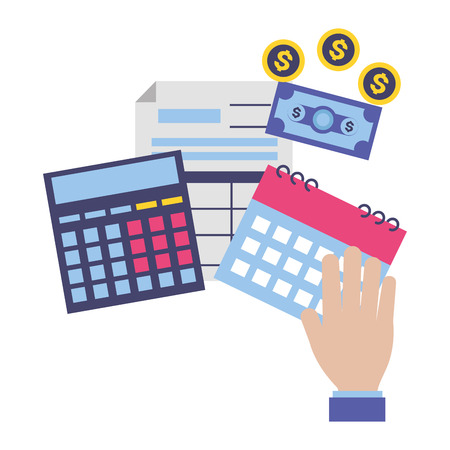Understanding Your Financial Landscape
Before you can start budgeting effectively, its important to get a clear picture of your personal finances. In the US, everyday expenses can add up quickly, and tracking them is the first step toward taking control of your money. Lets break down the basics so you can build a strong foundation for smart financial decisions.
Types of Expenses in the US
Americans typically deal with two main types of expenses: fixed and variable. Fixed expenses are regular payments that stay about the same each month, like rent or car payments. Variable expenses change depending on your lifestyle and choices—think groceries, eating out, or shopping. Heres a simple comparison:
| Fixed Expenses | Variable Expenses |
|---|---|
| Rent/Mortgage | Groceries |
| Car Payment | Dining Out |
| Health Insurance | Entertainment |
| Student Loans | Clothing |
| Internet/Phone Bill | Gasoline/Transportation |
Common Spending Habits in America
Many Americans use credit cards for daily purchases, which makes it easy to lose track of spending. Subscription services like streaming platforms or meal kits have also become more common, often leading to small monthly charges that add up over time. Impulse buys at major retailers or online stores can sneak into your budget without notice.
Why Tracking Expenses Matters
If you don’t keep an eye on where your money goes, it’s easy to overspend and fall short at the end of the month. Tracking expenses helps you:
- See exactly where your money is going each month
- Spot bad habits or unnecessary subscriptions draining your wallet
- Create realistic budgets based on your actual spending patterns—not just guesses
- Avoid overdraft fees or credit card debt by staying within your means
- Reach savings goals faster by cutting back where it counts most
The Bottom Line: Get Started with Awareness
The first step to mastering your budget is understanding all the ways money flows in and out of your life. By recognizing different expense types and knowing your own spending habits, you’ll be ready to take control and make better choices with your hard-earned cash.
2. Proven Methods for Tracking Expenses
Discovering Popular Expense Tracking Methods in America
Tracking your expenses is the foundation of effective budgeting. In the United States, people use a variety of methods to keep tabs on where their money goes. From modern digital apps to classic envelope systems, theres something that works for everyone. Lets explore these popular options and see which one might fit your lifestyle best.
Digital Apps: Effortless and Smart
Digital expense tracking apps have become super popular because they make managing money easy and convenient. Many Americans love using these apps since they automatically link to your bank accounts and credit cards, categorizing your purchases without much manual effort. Some top choices include Mint, YNAB (You Need A Budget), and EveryDollar.
Pros and Cons of Digital Apps
| App Name | Main Features | Best For |
|---|---|---|
| Mint | Automatic syncing, spending insights, bill reminders | Busy individuals who want automatic tracking |
| YNAB | Goal setting, real-time updates, proactive budgeting tools | Hands-on budgeters who want to plan every dollar |
| EveryDollar | User-friendly interface, zero-based budgeting approach | Beginners or fans of Dave Ramsey’s method |
Spreadsheets: Customizable and Flexible
If you like having full control over your finances, spreadsheets are a fantastic choice. Many Americans use Google Sheets or Microsoft Excel to track expenses manually. You can create custom categories, add formulas, and adjust layouts to match your needs. This method is perfect if you enjoy working with numbers and want a tailored solution.
How Spreadsheets Compare to Apps
| Digital Apps | Spreadsheets | |
|---|---|---|
| Automation Level | High – Syncs automatically with accounts | Low – Manual entry required |
| Customization | Limited by app features | Fully customizable layouts and categories |
| User Skill Needed | Beginner friendly | Easier for those familiar with spreadsheets |
| Cost | Free & paid versions available | Usually free (with existing software) |
The Envelope System: Tried-and-True Cash Management
The envelope system is an old-school but highly effective way to control spending. With this method, you physically divide your cash into envelopes labeled for different expenses—like groceries, entertainment, or gas. When the money in an envelope runs out, you’re done spending in that category until next month. Many Americans still use this technique because it creates strong spending awareness.
Who Should Use the Envelope System?
- If you tend to overspend with credit or debit cards.
- If you prefer handling cash and need visual cues to stay on track.
- If you want a simple, no-tech approach to budgeting.
Which Method Fits Your Lifestyle?
| Lifestyle/Preference | Best Method |
|---|---|
| I love technology & automation | Digital Apps (Mint, YNAB) |
| I want total control & customization | Spreadsheets |
| I prefer cash & visual organization | Envelope System |
Your Perfect Match Awaits!
No matter how you choose to track your expenses—whether its through an app, spreadsheet, or envelopes—the key is finding a method that feels natural and sustainable for you. Experiment with different approaches until you discover what helps you stick to your budget and reach your financial goals.

3. Harnessing Technology: Top Budgeting Apps and Tools
In todays digital age, managing your money is easier than ever thanks to a variety of powerful apps and online tools. These platforms are designed to help you track expenses, set budgets, and get real-time insights into your financial health—all from your smartphone or computer. Here’s a look at some of the most popular American budgeting apps and banking features that can help you take control of your spending.
Popular Budgeting Apps
| App Name | Main Features | Best For | Price |
|---|---|---|---|
| Mint | Automatic expense tracking, bill reminders, credit score monitoring, goal setting | Beginners & users who want everything in one place | Free (ads supported) |
| YNAB (You Need A Budget) | Zero-based budgeting, proactive planning, real-time syncing across devices, educational resources | People who want total control and hands-on budgeting | $14.99/month or $99/year (free trial available) |
| Personal Capital | Expense tracking, investment tracking, net worth calculation, retirement planning tools | Users interested in both spending and investing oversight | Free (wealth management services extra) |
| Goodbudget | Envelope-style budgeting, shared budgets for families/partners, manual entry for cash spenders | Couples & families who like envelope method | Free basic / $8/month premium |
| Your Bank’s App (e.g., Chase, Wells Fargo) | Automatic transaction updates, spending categories, instant alerts, mobile check deposit | Anyone who wants simple tracking without third-party apps | Free with account |
Key Benefits of Using Budgeting Apps and Digital Tools
- Simplified Tracking: Automatically categorize and track where every dollar goes—no more guessing or manual spreadsheets.
- Real-Time Updates: Most apps sync with your bank accounts and credit cards instantly so you always see up-to-date information.
- Customizable Budgets: Set limits for different categories like groceries, entertainment, or dining out, then get alerts if you’re nearing your limit.
- Financial Insights: Visual reports and charts make it easy to spot trends in your spending and see where you can save.
- Goal Setting: Many apps let you set savings goals or debt payoff targets—and track your progress along the way.
- User-Friendly Design: These platforms are made for everyone—from college students to busy parents—so you don’t need to be a finance expert to use them.
Tapping Into Your Bank’s Built-in Tools
If downloading another app isn’t your style, check out what your own bank offers. Major U.S. banks like Chase, Bank of America, and Wells Fargo have upgraded their apps with built-in expense trackers, budget-setting tools, and notifications. These are free with your account and often provide enough features for straightforward expense management.
Pro Tip: Sync All Accounts for a Full Picture
No matter which tool you choose, make sure to link all your checking accounts, savings accounts, credit cards—even loans—so you can see your entire financial picture in one place. This helps prevent any surprises and keeps you on top of your budget.
Your Next Step: Try an App That Fits Your Style!
The best way to find the right tool is to try one or two that match your needs. Most offer free versions or trials so you can explore their features before making a commitment. With the right digital help, keeping tabs on your expenses can be quick—and even kind of fun!
4. Budgeting Strategies That Work
If you want to make your money work for you, choosing the right budgeting strategy is a game-changer. In the United States, several popular methods can help you take control of your finances and reach your goals. Here’s a closer look at three tried-and-true approaches: the 50/30/20 rule, zero-based budgeting, and cash flow analysis.
The 50/30/20 Rule
This simple method helps you divide your after-tax income into three main categories: needs, wants, and savings or debt repayment. Here’s how it breaks down:
| Category | Percentage of Income | Examples |
|---|---|---|
| Needs | 50% | Rent/mortgage, utilities, groceries, insurance, transportation |
| Wants | 30% | Dining out, entertainment, hobbies, vacations |
| Savings/Debt Repayment | 20% | Emergency fund, retirement accounts, student loans, credit card payments |
This rule is popular because it’s easy to follow and gives you flexibility. To get started, calculate your monthly income after taxes and assign the appropriate amount to each category. Adjust as needed if you find one area is consistently over or under budget.
Zero-Based Budgeting
With zero-based budgeting (ZBB), every dollar has a job. At the start of each month, you plan where every cent will go—so your income minus expenses equals zero by the end of the month.
How It Works:
- List all sources of monthly income.
- Write down every expected expense—including bills, groceries, fun money, and savings.
- Assign amounts to each category until your income minus expenses equals zero.
- If you have money left over, assign it to savings or debt repayment.
This method helps you be intentional with your spending and ensures nothing falls through the cracks. Many people use apps like YNAB (You Need a Budget) to make zero-based budgeting easier to manage.
Cash Flow Analysis
If you want a big-picture view of your finances, cash flow analysis can help. This approach tracks how much money comes in versus how much goes out over a certain period—typically monthly.
Steps for Cash Flow Analysis:
- Add up all sources of income (paychecks, side gigs, investments).
- Total all expenses (fixed and variable).
- Subtract expenses from income to see if you’re in the black (positive) or red (negative).
This strategy is especially useful if your income fluctuates or if you’re self-employed. By regularly checking your cash flow, you’ll spot trends—like seasonal expenses or months when you overspend—and can adjust accordingly.
Tips for Applying These Strategies to Your Financial Goals
- Start simple: If youre new to budgeting, try the 50/30/20 rule first.
- Tweak as needed: Life changes—so should your budget! Revisit it monthly or quarterly.
- Use technology: Budgeting apps and online tools can automate tracking and make it less stressful.
- Stay flexible: Don’t get discouraged if things don’t go perfectly every month; consistency is key.
- Tie budgets to goals: Whether saving for a house or paying off debt, align your budget with what matters most to you.
5. Staying Accountable and Adapting Your Budget
Keep Yourself on Track: Accountability Matters
Sticking to your budget is easier said than done, but accountability can make a huge difference. Here are a few ways to help you stay motivated and stick to your financial plan:
- Set Clear Goals: Whether it’s paying off debt or saving for a vacation, having specific targets helps you stay focused.
- Use Visual Reminders: Post sticky notes with your goals on your fridge, or set reminders on your phone.
- Check In Weekly: Schedule a short “money date” every week to review your spending and see where you stand.
- Find an Accountability Buddy: Team up with a friend or family member who also wants to manage money better. Share updates and encourage each other.
Regularly Review Your Spending Habits
Reviewing your expenses isn’t just about looking for mistakes—it’s about understanding your habits and finding opportunities to improve. Here’s a simple table to help organize your monthly review:
| Category | Budgeted Amount | Actual Spent | Difference |
|---|---|---|---|
| Groceries | $400 | $380 | $20 under |
| Dining Out | $150 | $200 | $50 over |
| Utilities | $120 | $110 | $10 under |
| Entertainment | $80 | $75 | $5 under |
| Savings | $300 | $250 | $50 under goal |
This table helps you see at a glance where you’re doing well and where you might need to adjust.
Adapting Your Budget for Life’s Changes
Your budget shouldn’t be set in stone—it should grow and change along with your life. If you get a new job, face unexpected expenses, or decide to make a major purchase, it’s time to revisit your spending plan. Here’s how you can adapt smoothly:
- Assess the Change: Is it temporary (like holiday shopping) or long-term (like moving cities)? Adjust accordingly.
- Create New Categories: Big changes may mean adding or removing budget categories—for example, “Home Renovation” or “Childcare.”
- Cushion for Surprises: Set aside a little extra in an “emergency fund” category so surprises don’t throw off your whole plan.
- Pace Yourself: If making a big purchase, break down payments into manageable monthly amounts instead of one large hit to your budget.
Lifestyle Shifts: Making Your Budget Work for You
If you’re transitioning to remote work, starting a family, or picking up new hobbies, those shifts will affect your expenses. Take time each month to ask yourself if your budget still fits your lifestyle. Small tweaks now can prevent bigger headaches later!
Quick Checklist for Budget Adaptation:
- Did anything major change this month?
- Are there new income sources or expenses?
- Does my current spending reflect my values and priorities?
- Have I made room for savings and fun?
- What can I tweak to make next month even better?
The more proactive you are about reviewing and adjusting, the more empowered youll feel when it comes to managing your money—no matter what life throws at you.


